Drifting along a waterway in your kayak is a great way to pass a few hours. Casting a few lures or baits with the possibility of catching a fish and you could not ask for a better way to chill out.
But what do we do when we know fish are holding up on structure but current flow means we can’t stay still long enough to catch them? We anchor up.
I like to target bream in a shallow stretch of water near where I live. It’s encircled with oyster formations and rocky outcrops and there is certainly no drifting at this spot, a bloke needs to be anchored up and play the waiting game but the wait is usually worth it.
I have seen people use many types of objects for anchors in kayaks, from house bricks to large blocks of steel and gym weights. (Dave Seaman even used a gumboot filled with concrete and an eyebolt attached! – Editor).
Obviously an appropriate anchor is our first requirement. Next off the rank are an adequate amount of anchor rope or strong cord, a stainless D shackle and a medium to large hand caster or something to store your rope on.
When using a grapnel-type anchor, I opt to use some chain to help weigh it down and dig in.
The rope has to be tied off in the right place and if it is not tied off correctly, you can easily get into trouble. I have witnessed some people tie the anchor rope around their waist!
The bow is the correct and safest place. If you tie off on the side or around your waist your ’yak will be side on to the current and there is a very good chance that if you are in a sit-in kayak, it won’t be too long before you will be bailing out water. You could even roll.
Tying off to the bow keeps your craft nose into the current and keeps you dry and safe.
There are a few ways to anchor your ’yak from the bow and all will cost you a few dollars, some more than others.
I have not seen too many kayak anchoring systems on the market. The ones I have seen have cords, pulleys and/or long poles you stick into the sand to hold you.
I believe the Scotty anchoring system is the best compact unit on the market for use in a shallow estuary.
It is designed for small boats, canoes and kayaks. The anchor lock is made of the same high-impact plastic that all Scotty products are and the fittings are marine-grade stainless steel.
The Scotty is easy to fit. The anchor lock system has two mounting options, either as a fixture or it can be removable by using a universal Scotty base.
One end of the rope is tied to the anchor, the other is passed up from below and over the roller at the front of the unit.
The rope is then passed through the hole in the locking cleat. As the ’yak drifts back and the cleat is released by lifting the anchor cord up high, the anchor will drop down.
When the desired amount of cord is out, drop your arm down to cleat level and the small one-way teeth lock the cord.
When you want to retrieve the anchor, just pull the rope up high and this releases the jam cleat, then just pull the rope in.
Once up, the anchor is secured on the nose of the craft by this nifty cleat until you wish to deploy it again.
The Scotty anchoring system is available at all quality tackle stores. I picked mine up from McCallums in Nowra.
To make your own set-up will require only four items. You will need a length of heavier rope (a nose rope) to go from the bow to where you sit – about 3m is good.
A small float about the size of a tennis ball needs to be able to support a carabiner-style release clip and your anchor cord. A hand caster or something to wind your anchor cord onto is an essential.
Check out the pics and note the anchor rope has to be long enough to be secured in the cockpit after the anchor has been set.
When you pull the anchor line in, it will pull the nose rope, clip and float back to you.
The float is needed to keep the clip and rope from sinking down out of reach. With the clip floating, you just paddle up to it and bring it onto the ’yak.
The first anchor I used was a galvanised grapnel type. It was a folding type and was compact but heavy and had four arms that stuck out when unfolded.
For the bloke who has everything, I know you can also get them in a 700g kayak size in stainless steel from www.miyaepoch.com.au.
When surfing the net, I stumbled across an anchor that caught my eye simply because it was cosmic pink. I’d discovered the Cooper Anchor by accident, you might say.
These nifty little anchors were designed for jet skis and kayaks. They come in pink and blue, weigh only 900g and they do hold on.
These anchors are made of glass-reinforced nylon, are very durable and light, yet grip like mud to a blanket. Even with a length of chain they are not noisy and take up bugger-all room.
These anchors will also stand up to plenty of wear and tear, including oysters and rocks.
On the day I first tested the Scotty I tried two anchors, the folding grapnel of 2.5kg with about 1.2m of galvanised chain, and a new 900g Cooper with the same amount of chain.
After that I tested each without the chain.
The chain didn’t work too well going through the roller in the front of the Scotty.
Once released from the Scotty lock, both the grapnel and the Cooper hit the bottom without problems. The cord from the grapnel went through the hands quicker, owing to the greater weight.
However, the Cooper dug in better than the grapnel even though it was lighter by a heap, and it was a lot less noisy.
Once up, both anchors hung in the water by a few feet because the chain wouldn’t pass through the roller. So I took the chain off.
The grapnel sank like a rock and when pulled up, cleared the water and could be locked against the roller.
Minus the chain, the Cooper was a tad light and did not pull the cord through the roller and cleat.
So I got some chain the length of the Cooper’s shank and attached it via a shackle and a cable tie. That chain was all it took for the anchor to drop from the lock.
It wasn’t as quick as the grapnel but when it hit, it dug in.
To make things look pretty with the pink anchor, I fitted a piece of red heat shrink over the length of chain – I must be getting old!
The Cooper was outstanding in sand and on a rough bottom. The grapnel tended to drift a little in sand.
The chain helped to set both anchors much faster. Without chain, more rope was needed.
The grapnel anchor works fine as long as there is a rough or structured bottom for it to grab on to.
In sand, even though heavier, the grapnel anchor slipped a bit. It also weighs a few kilos it was heavy and metal to metal always makes noise – not good when chasing easily spooked fish.
Facts
THE COOPER ANCHOR
The Cooper has two attachment points on the shaft. Put a small D-shackle on the end of the rope and through the hole closest to the blade. Then lay your rope, or chain if you choose to use it, along the shaft and pass a cable tie (not too big) through the top hole.
In the event your anchor snags up on the bottom, pull hard on the rope and the cable tie should snap and your anchor can then be pulled out blade end first.
Another great design feature is that no matter which way the Cooper lands when deployed, it sets quickly due to its unique design and weight distribution.
Visit www.cooperanchors.com to see how and why this interesting anchor does this.
Coopers is a family-owned Australian company that also makes the same style of anchor in aluminium for boats of all sizes. It is so good to see Aussies having a go in such a competitive market.
Price wise they are they are great value for money.
I do not get any payment from the companies mentioned. I use these products because they work for me and I hope these hints help you in setting up your kayak to make your fishing more comfortable, safe and enjoyable.
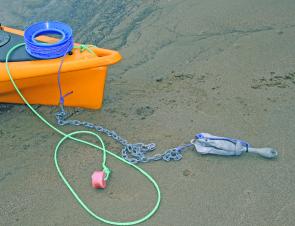
The DIY set-up: Grapnel anchor, chain, and anchor line on a handcaster. The nose rope has a float and the loop in the end for a stainless carabiner, not seen here. The nose rope clips to, and takes the anchor strain from, a loop tied in the anchor line. T
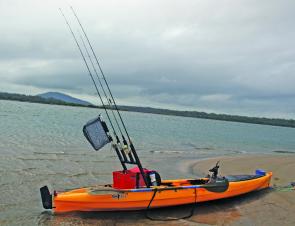
All ready to fish.
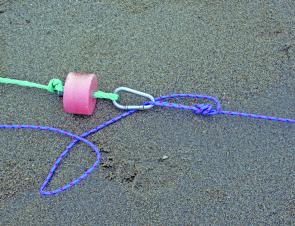
The float keeps the nose rope on the surface and the carabiner clip attaches to a loop on the thin, strong anchor line.
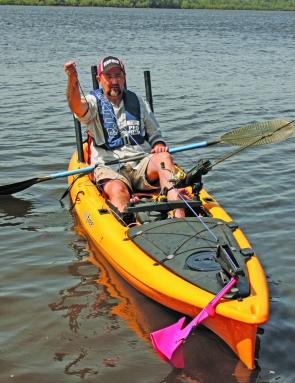
Ron releases the cooper anchor by lifting the cord high.

The Scotty Anchor Lock is a neat and tidy device that doubles as a bow roller and jam cleat for instant anchoring and retrieval.
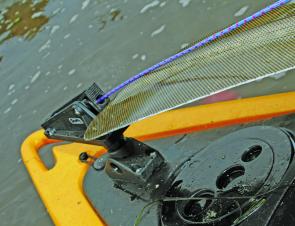
Use the tip of the paddle to hold the cleat up from the seat position.
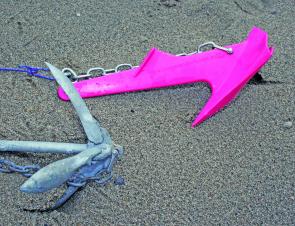
The grapnel and the Cooper anchor side by side. The Cooper really digs in easily and holds well.
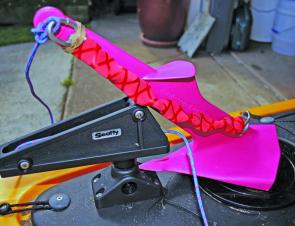
The light, efficient Cooper anchor needs a little chain to add enough weight to engage the Scotty. The author added heat shrink on the chain for aesthetics, to cut noise and reduce the possibility of scratching. It works!




